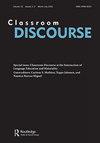Translanguaging and scaffolding as pedagogical strategies in a primary bilingual classroom
IF 1.6
Q2 EDUCATION & EDUCATIONAL RESEARCH
引用次数: 3
Abstract
ABSTRACT This study aimed at investigating when, and for which purposes, teachers and pupils translanguaged in a third-grade classroom [8–9 year olds] in a private bilingual school in northern Portugal. It also aimed at highlighting effective scaffolding strategies developed by the teachers in the Natural and Social Sciences (NSS) and English Language (EL) lessons. Classroom observations were conducted for a six-month period. Data was collected through participant-observation, using a single case study design with multiple embedded units of analysis. Data analysis was performed qualitatively by analysing language use in fieldnotes from classroom observations, audio recordings of NSS and EL lessons, and a pupil survey and also through content analysis for teachers’ written reflections. A total of 26 categories were derived under different types of translanguaging and scaffolding strategies used both by the teachers and the pupils. It was found that translanguaging was used for the teaching of content and to establish communication, and it was both teacher-directed and pupil-directed. Findings have implications for educators when considering how translanguaging can be used as a pedagogical tool in Content and Language Integrated Learning (CLIL) classrooms.小学双语课堂教学策略的翻译与框架
本研究旨在调查葡萄牙北部一所私立双语学校的三年级(8-9岁)教师和学生何时以及出于何种目的进行跨语言教学。它还旨在突出教师在自然和社会科学(NSS)和英语语言(EL)课程中制定的有效脚手架策略。课堂观察进行了六个月。通过参与者观察收集数据,使用具有多个嵌入式分析单元的单一案例研究设计。通过分析课堂观察、NSS和EL课程的录音、学生调查以及教师书面反思的内容分析,定性地分析了现场笔记中的语言使用情况。在教师和学生使用的不同类型的译语和脚手架策略下,共得到26个类别。研究发现,跨语言教学主要用于内容教学和建立交流,并且是教师导向和学生导向的。研究结果对教育工作者在考虑如何在内容和语言综合学习(CLIL)课堂中使用翻译语言作为教学工具具有启示意义。
本文章由计算机程序翻译,如有差异,请以英文原文为准。
求助全文
约1分钟内获得全文
求助全文

 求助内容:
求助内容: 应助结果提醒方式:
应助结果提醒方式:


